Charles E W Bean, Diaries, AWM38 3DRL 606/274A/1 - 1918 - 1941 - Part 2
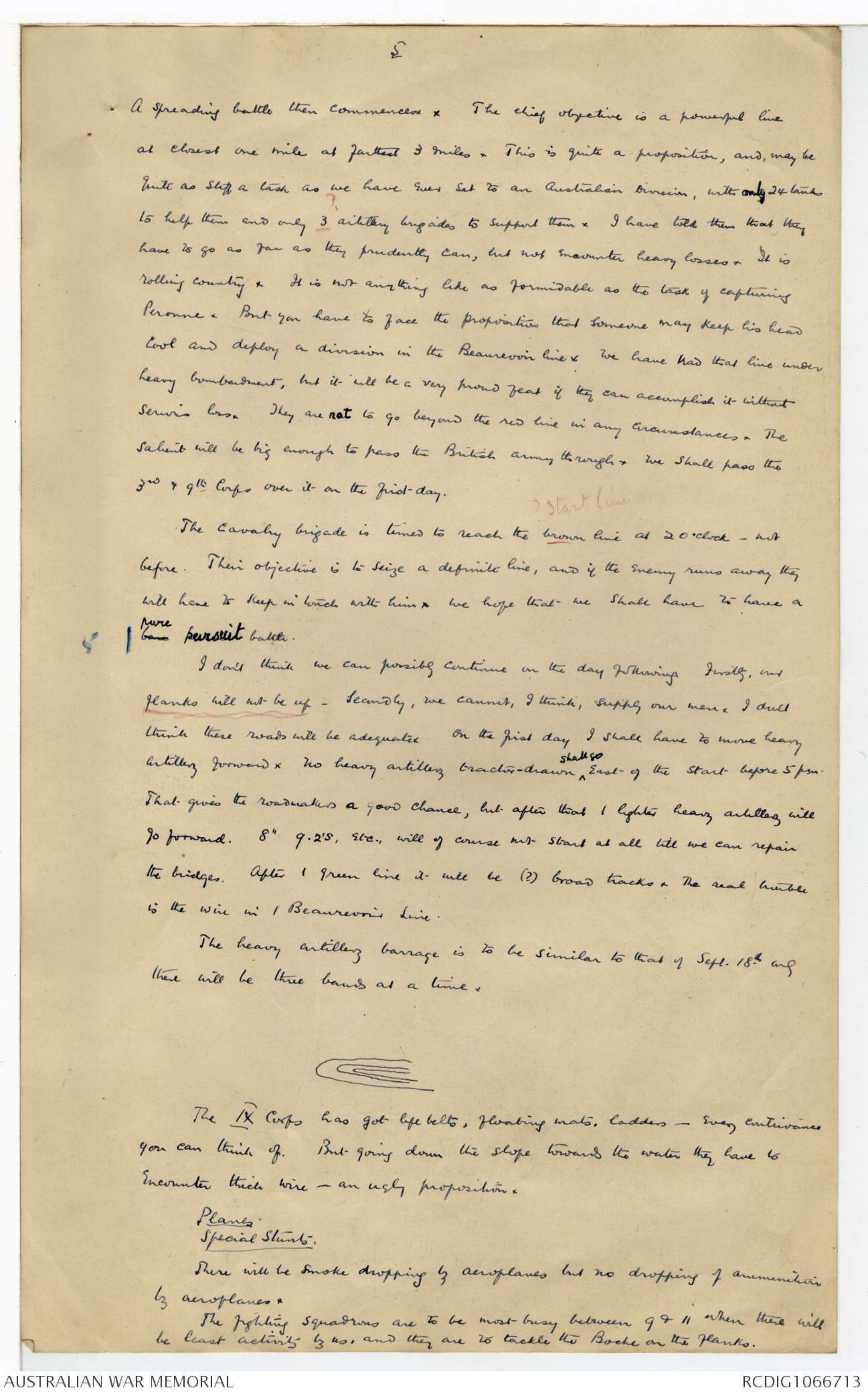
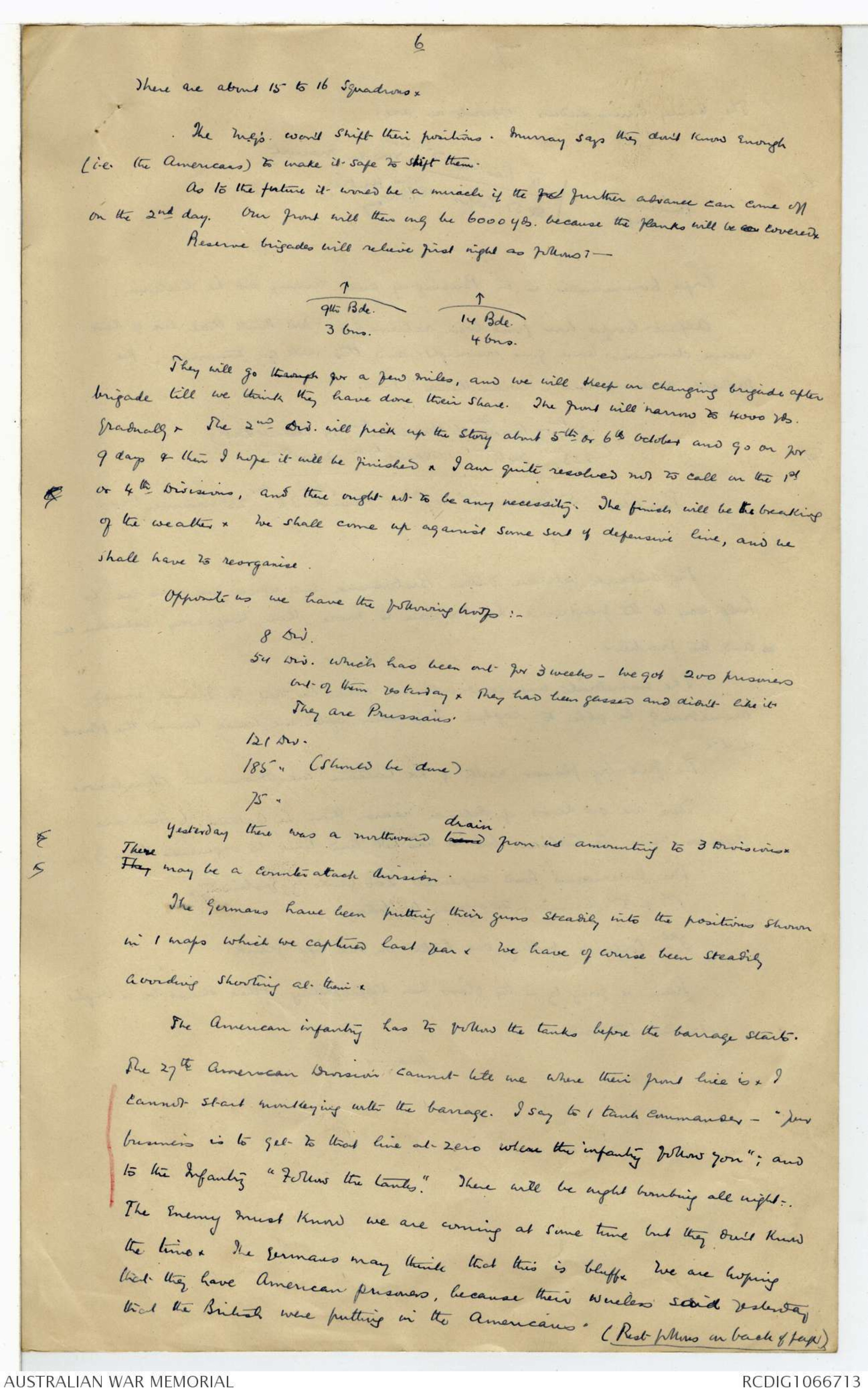
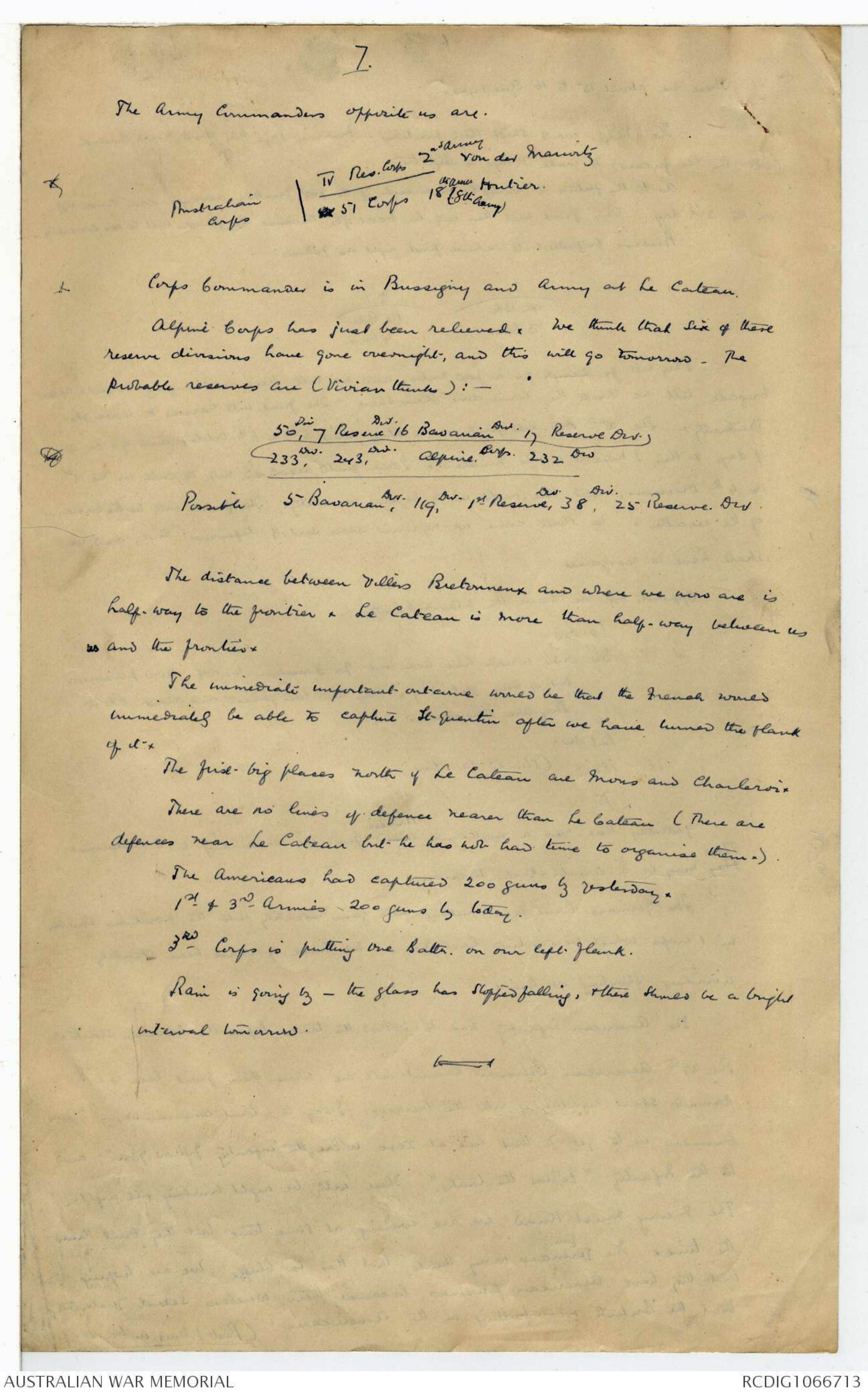
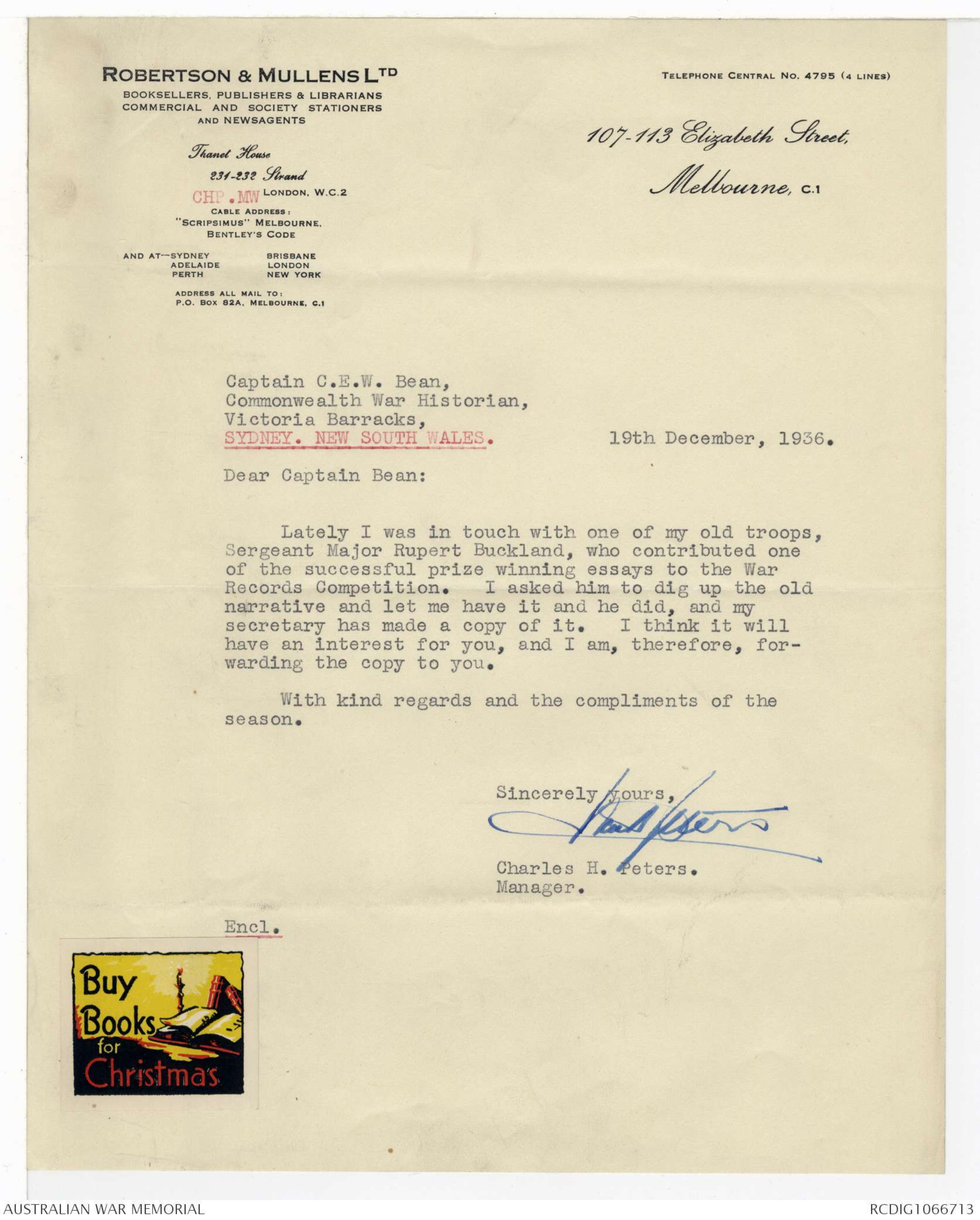
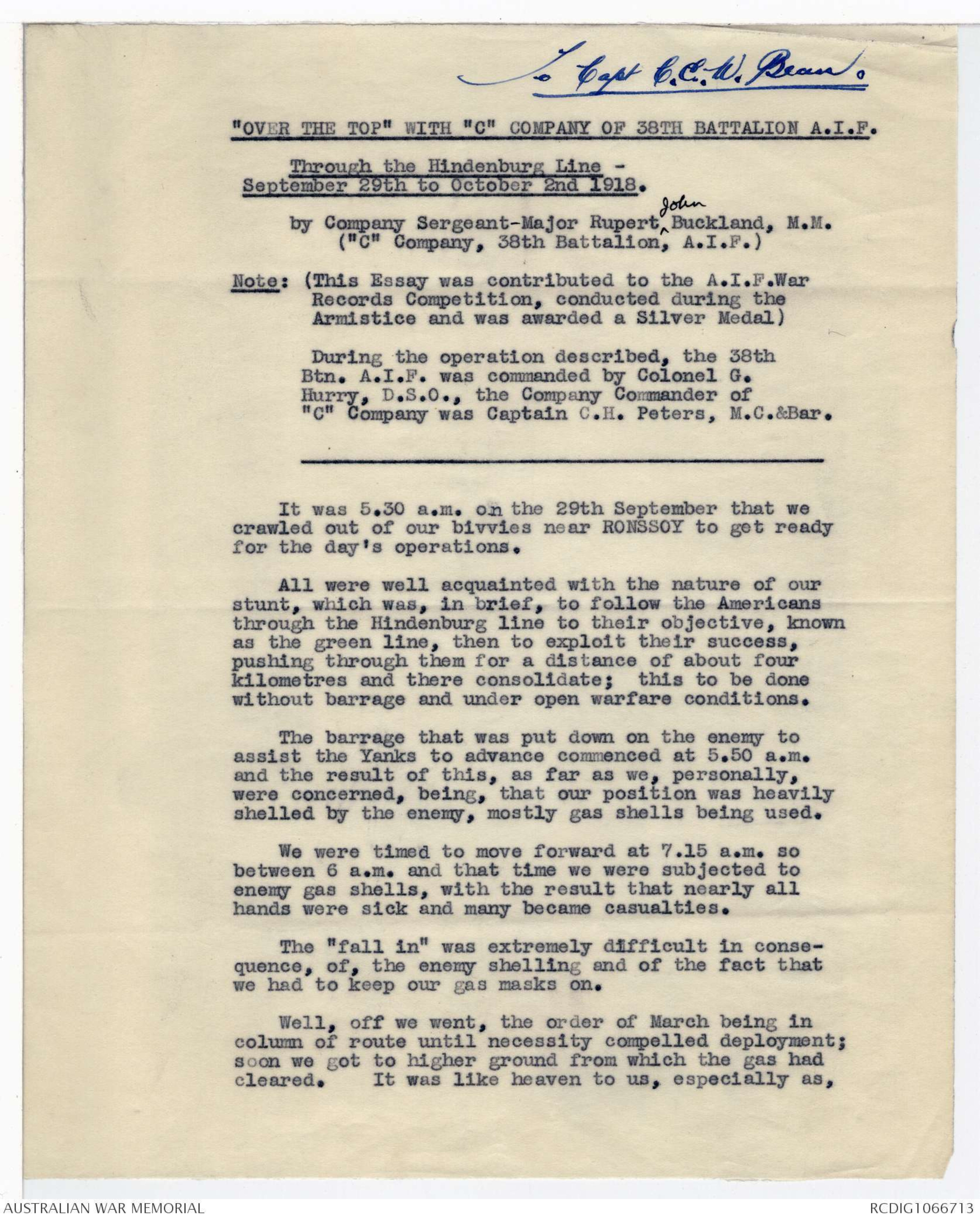
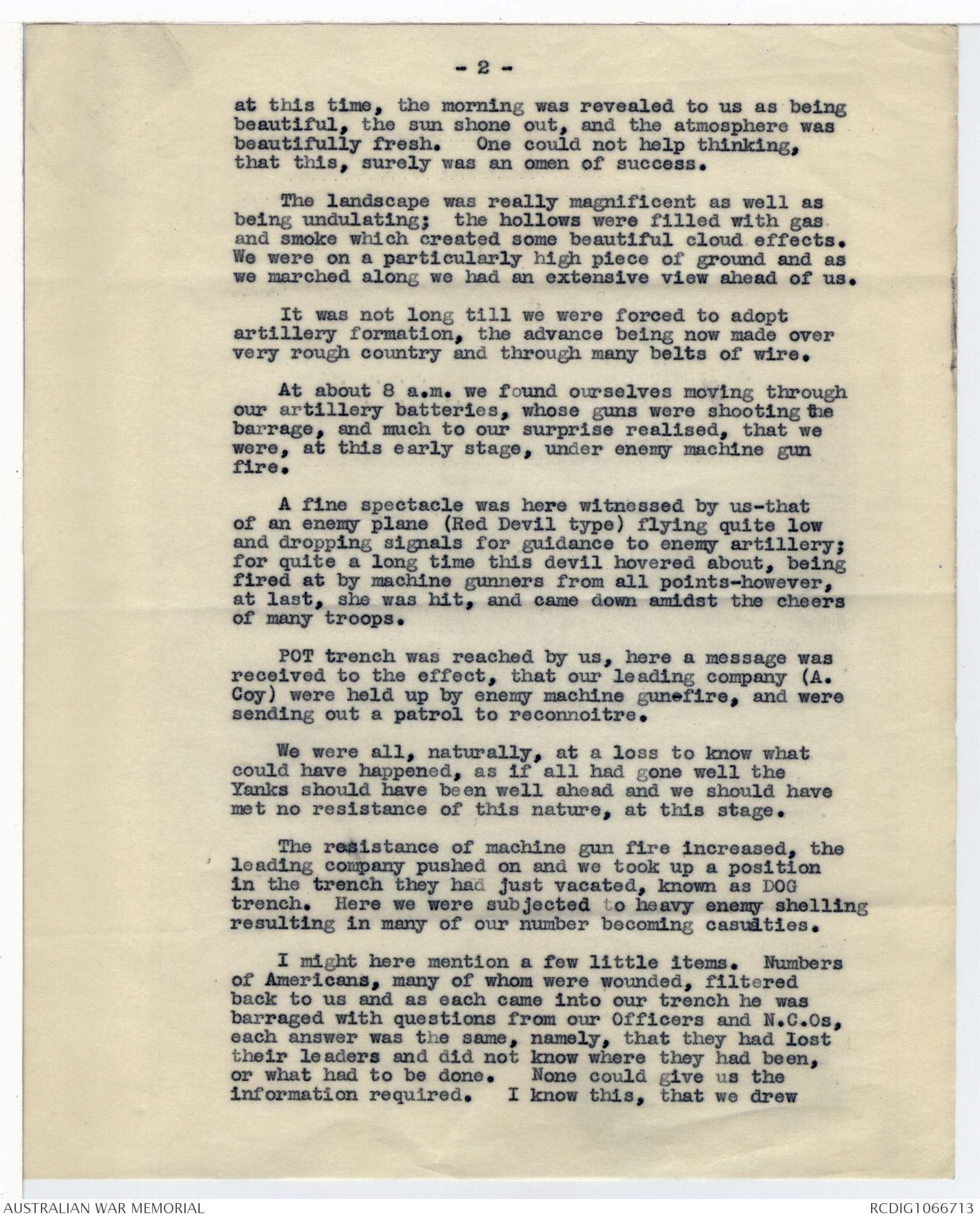
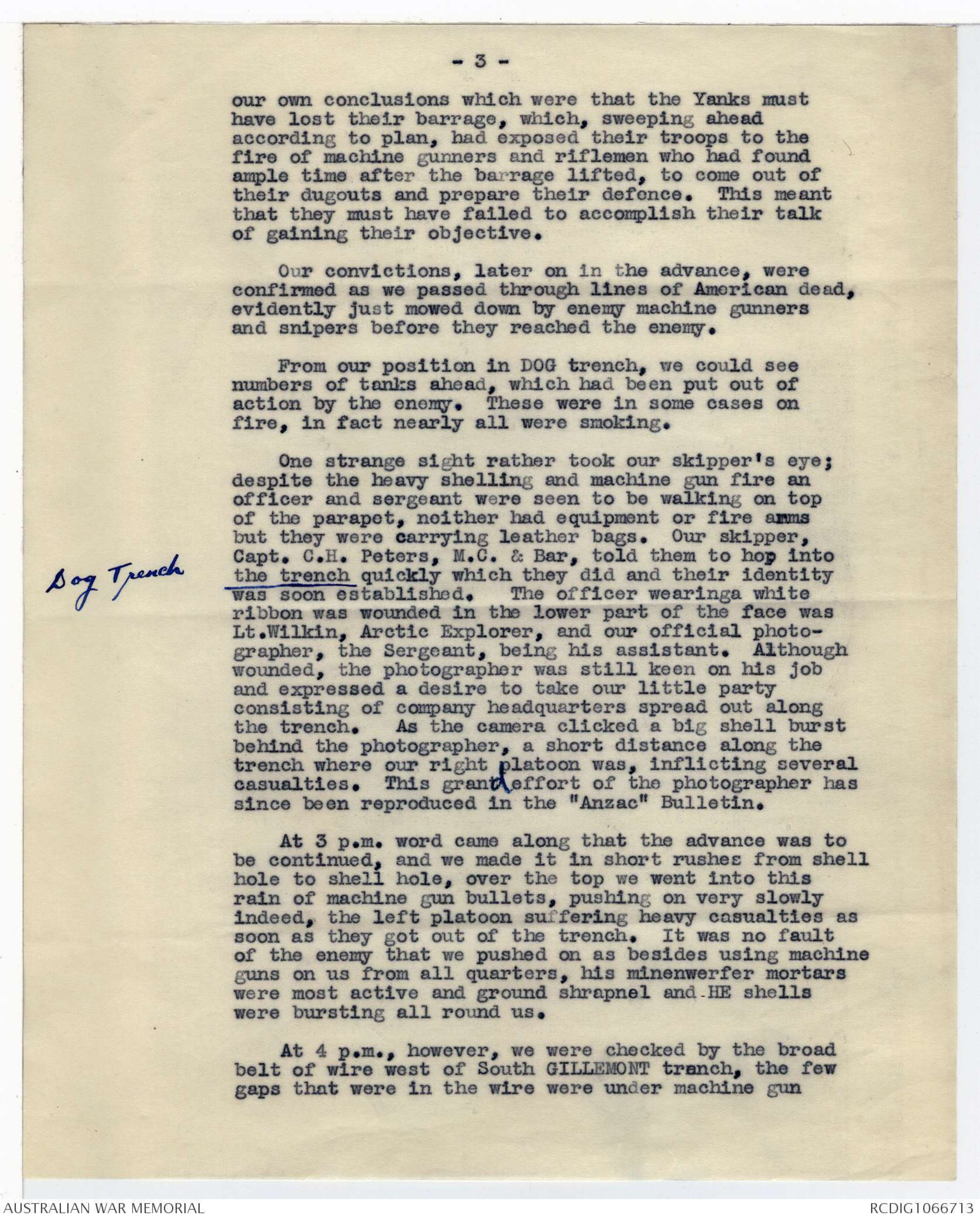
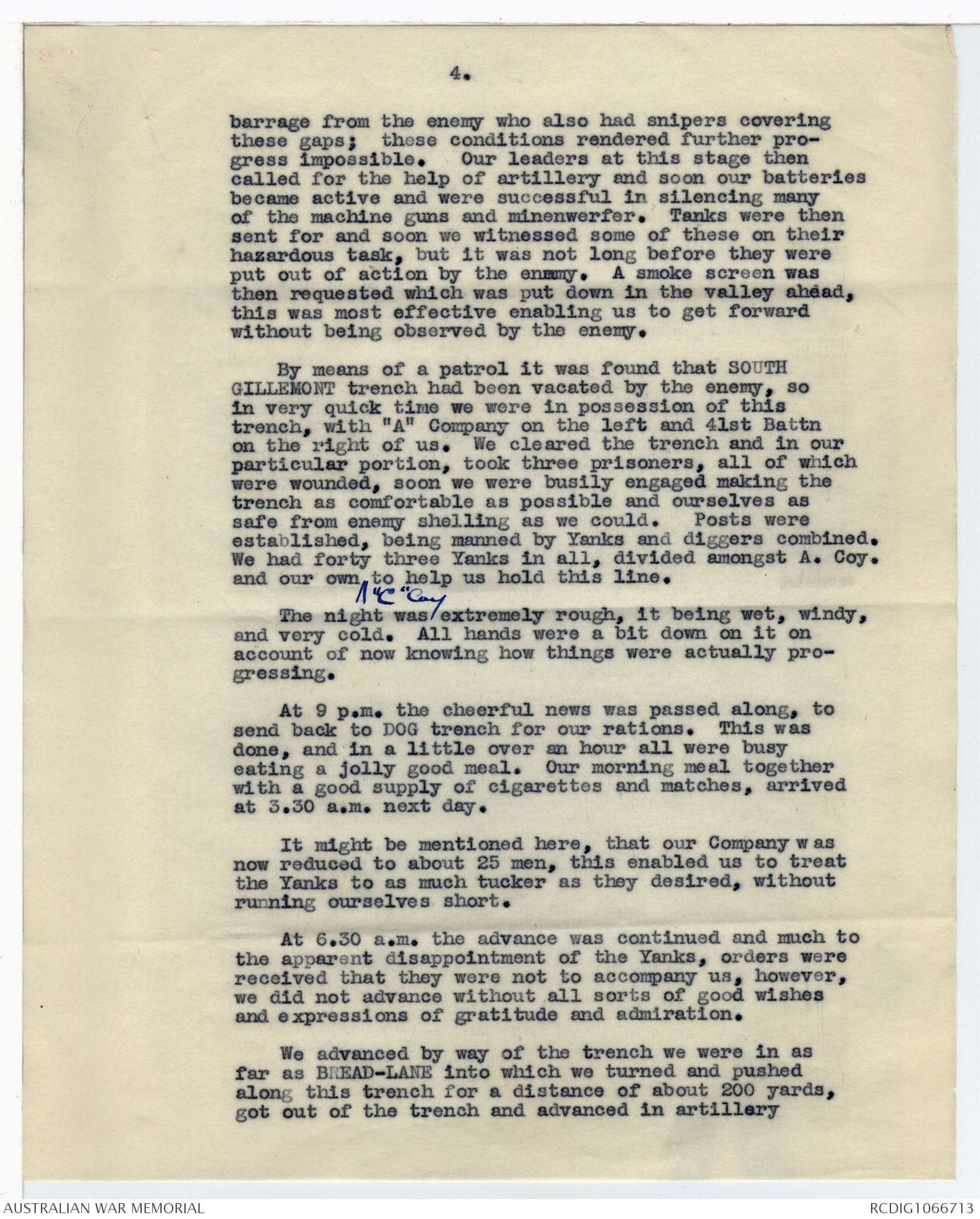
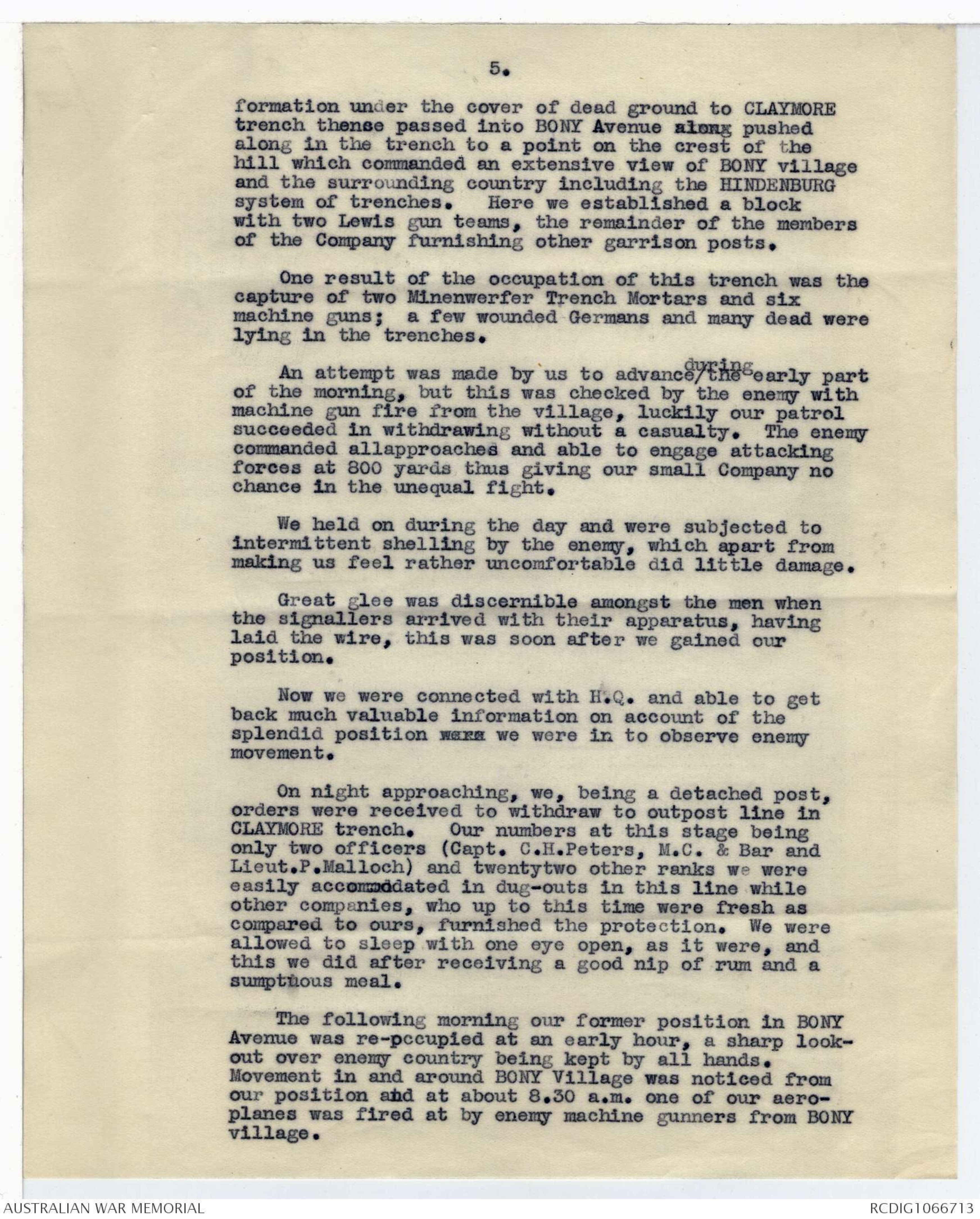
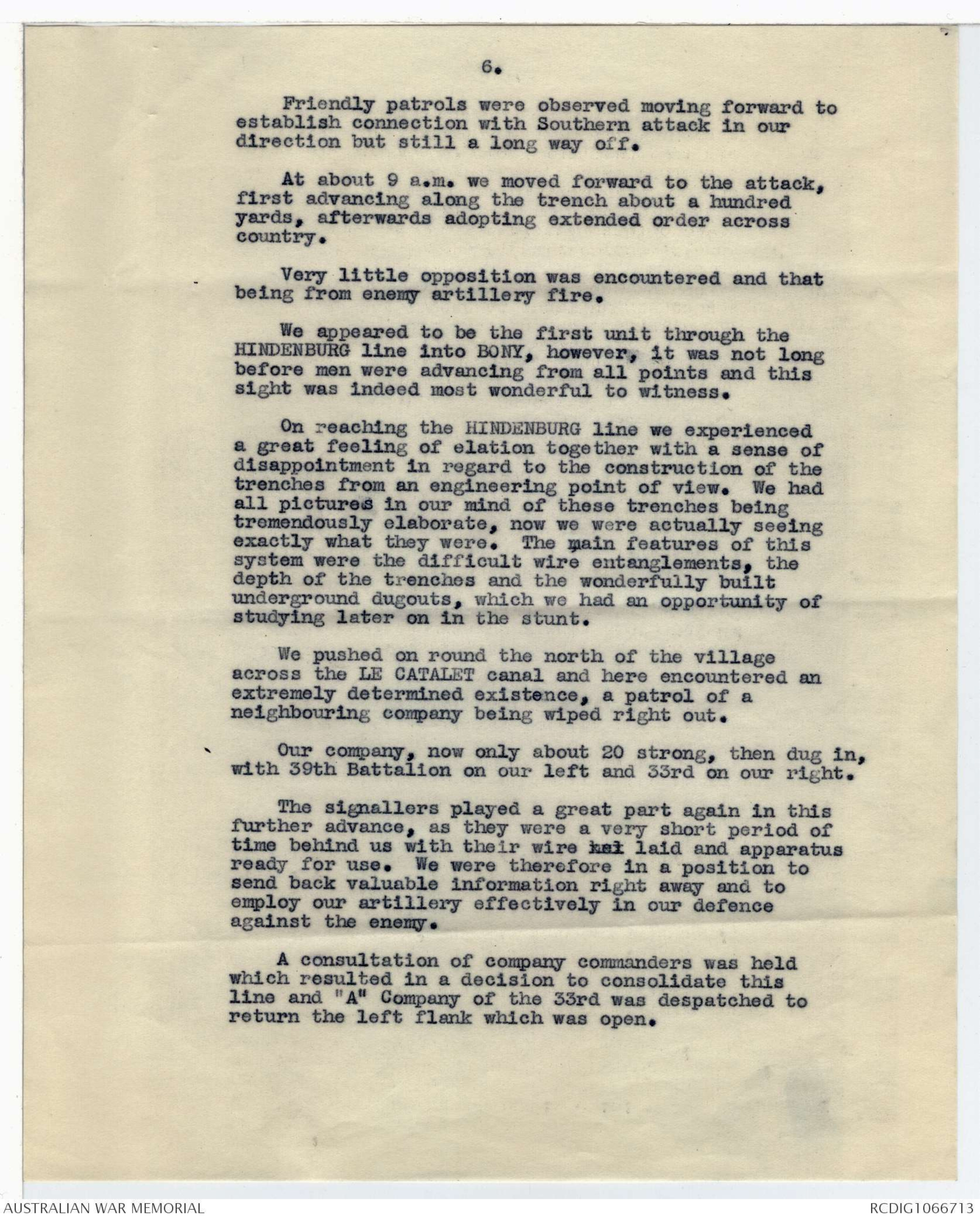
5
A spreading battle then commences. The chief objective is a powerful line
at closest one mile at farthest 3 miles. This is quite a proposition, and, may be
quite as stiff a task as we have ever set to an Australian Division, with only 24 true
to help them and only 3 artillery brigades to support them. I have told them that they
have to go as far as they prudently can, but not encounter heavy losses. It is
rolling country. It is not anything like as formidable as the task of capturing
Peronne. But you have to face the proposition that someone may keep his head
Cool and deploy a division in the Beaurevoir line. We have had that line under
heavy bombardment, but it will be a very proud feat if they can accomplish it without
Serious loss. They are not to go beyond the red line in any circumstances. The
Salient will be big enough to pass the British army through. We shall pass the
3rd & 9th Corps over it on the first day.
The Cavalry brigade is timed to reach the brown line at 2 0’clock – not
before. Their objective is to seize a definite line, and if the Enemy runs away they
will have to keep in touch with him. we hope that we shall have to have a
pure pursuit battle.
I don't think we can possibly continue in the day following. Firstly, our
flanks will not be up – Secondly, we cannot, I think, supply our men. I dont
think these roads will be adequate. On the first day I shall have to move heavy
artillery forward. No heavy artillery tractor-drawn ^ shall go East of the start before 5pm.
That gives the roadmakers a good chance, but after that the lighter heavy artillery will
go forward. 8' 9.2's, Etc., will of course not start at all till we can repair
the bridge. After the green line it will be (?) broad tracks. The real trouble
is the wire in the Beaurevoir Line.
The heavy artillery barrage is to be similar to that of Sept. 18th and
there will be three bands as a time.
Diagram - see original document
The IX Corps has got life belts, floating mats, ladders – Every contrivance
you can think of. But going down the slope towards the water they have to
Encounter thick wire - an ugly proposition.
Planes
Special Stunt
There will be smoke dropping by aeroplanes but no dropping of ammunition
by aeroplanes.
The fighting squadrons are to be most busy between 9 & 11 when there will
be least activity by us, and they are 2 tackle the Boshe on the flanks.
6
There are about 15 to 16 Squadrons.
The Mg's. won't Shift their positions. Murray says they don't know enough
(ie the Americans) to make it safe to shift them.
As to the future it would be a miracle if the fel further advance can come off
on the 2nd day. Our front will then only be 6000 yds. because the flanks will be covered.
Reserve brigades will relieve first night as follows:-
Diagram - see original document
They will go through for a few miles, and we will keep on changing brigade after
brigade till we think they have done their share. The front will narrow to 4000 yds.
gradually. The 2nd Div. will pick up the story about 5th or 6th October and go on for
9 days & then I hope it will be finished. I am quite resolved not to call on the 1st
or 4th Divisions, and there ought not to be any necessity. The finish will be the breaking
of the weather. We shall come up against some sort of defensive line, and we
shall have to reorganise
Opposite us we have the following corps:-
8 Div
5th Div. which has been out for 3 weeks - We got 200 prisoners
out of them yesterday. They had been gassed and didn't like it
They are Prussians.
121 Div.
185 " (should be done)
75 "
Yesterday there was a northward turn drain from us amounting to 3 Divisions.
There they may be a counterattack diversion.
The Germans have been putting their guns steadily into the positions shown
in the maps which we captured last year. We have of course been steadily
avoiding shooting at them.
The American infantry has to follow the tanks before the barrage starts.
The 27th American Division cannot tell me where their from line is. I
cannot start monkeying with the barrage. I say to the tank commander - "your
business is to get to that line at zero where the infantry follow you "; and
to the Infantry. "Follow the tanks ". There will be night bombing all night.
The Enemy must know we are coming at some time but they don't know
the time. The Germans may think that this is bluff. We are hoping
that they have American prisoners, because their wireless sand yesterday
that the British were putting in the Americans ' (Rest follows on back page of paper)
7.
The Army Commanders opposite us are ·
Australian Corps | Tv Res Corps 2nd annex Yonder Mauritz
| xx51 Corps 18th Amer frontier (8th army)
Corps Commander is in Bussigny and Army at the Catean
Alpine Corps has just been relieved. We think that Six of these
reserve divisions have gone overnight, and this will go tomorrow. The
probable reserves are (Vivian thinks):-
50Div, 7 Reserve ^Div 16 Bavarian Div. 17 Reserve Div.
233Div, 243Div., Alpine.Corps 232Div
Possible 5 Bavarian Divs, 119, Div. 1st Reserve Div, 38 Div, 25 Reserve. Div.
The distance between Villers Bretennenx and where we now are is
half-way to the frontier. Le Cateau is more than half-way between usas and the frontier.
The immediate important [?] would be that the French would
immediately be able to capture St. Quentin after we have turned the flank
of it.
The first-big places north of Le Catean are Mons and Charleroi.
There are no lines of defence nearer than Le Catean (There are
defences near Le Cateau but he has not had time to organise them.)
The Americans had captured 200 guns by yesterday.
1st & 3rd Armies 200 guns by today.
3RD Corps is putting One Batten, on our left flank.
Rain is going by – the glass has stopped falling, & there should be a bright
interval tomorrow.
ROBERTSON & MULLENS LTD
BOOKSELLERS, PUBLISHERS & LIBRARIANS
COMMERCIAL AND SOCIETY STATIONERS
AND NEWSAGENTS
Thanet House
231-232 Strand
CHP.MW LONDON W.C.2
CABLE ADDRESS:
"SCRIPSIMUS" MELBOURNE.
BENTLEY'S CODE
AND AT-SYDNEY BRISBANE
ADELAIDE LONDON
PERTH NEW YORK
ADDRESS ALL MAIL TO.
P.O. BOX 82A, MELBOURNE, C.1
Telephone Central No. 4795 (4 LINES)
107-113 Elizabeth Street
Melbourne, C.1
19th December, 1936.
Captain C. E. W. Bean,
Commonwealth War Historian,
Victoria Barracks,
SYDNEY. NEW SOUTH WALES.
Dear Captain Bean:
Lately I was in touch with one of my old troops,
Sergeant Major Rupert Buckland, who contributed one
of the successful prize winning essays to the War
Records Competition. I asked him to dig up the old
narrative and let me have it and he did, and my
secretary has made a copy of it. I think it will
have an interest for you, and I am, therefore,
forwarding the copy to you.
With kind regards and the compliments of the
Season.
Sincerely yours
[signature]
Charles H. Peters.
Manager.
Encl.
Buy
Books
for Christmas
[*To Capt. C.E.W. Bean*]
"OVER THE TOP" WITH "C" COMPANY OF 38TH BATTALION A.I.F.
Through the Hindenburg Line
September 29th co October End 1918.
by Company Sergeant-Major Rupert ^John Buckland, M.M.
("C" Company, 38th Battalion, A.I.F.)
Note: (This Essay was contributed to the A.I.F.War
Records Competition, conducted during the
Armistice and was awarded a Silver Medal)
During the operation described, the 38th
Btn. A.I.F. was commanded by Colonel G.
Hurry, D.S.O., the Company Commander of
"C" Company was Captain C. H. Peters, M.C. & Bar.
It was 5.30 a.m. on the 29th September that we
crawled out of our bivvies near RONSSOY to get ready
for the day's operations.
All were well acquainted with the nature of our
stunt, which was, in brief, to follow the Americans
through the Hindenburg line to their objective, known
as the green line, then to exploit their success
pushing through them for a distance of about four
Kilometres and there consolidate; this to be done
without barrage and under open warfare conditions.
The barrage that was put down on the enemy to
assist the Yanks to advance commenced at 5.50 a.m.
and the result of this, as far as we, personally,
were concerned, being, that our position was heavily
shelled by the enemy, mostly gas shells being used.
We were timed to move forward at 7.15 a.m. so
between 6 a.m. and that time we were subjected to
enemy gas shells, with the result that nearly all
hands were sick and many became casualties.
The "fall in" was extremely difficult in
consequence, of, the enemy shelling and of the fact that
we had to keep our gas masks on.
Well, off we went, the order of March being in
column of route until necessity compelled deployment;
soon we got to higher ground from which the gas had
cleared. It was like heaven to us, especially as,
-2-
at this time, the morning was revealed to us as being
beautiful, the sun shone out, and the atmosphere was
beautifully fresh. One could not help thinking,
that this, surely was an omen of success.
The landscape was really magnificent as well as
being undulating; the hollows were filled with gas.
and smoke which created some beautiful cloud effects.
We were on a particularly high piece of ground and as
we marched along we had an extensive view ahead of us.
It was not long till we were forced to adopt
artillery formation, the advance being now made over
very rough country and through many belts of wire.
At about 8 a.m. we found ourselves moving through
our artillery batteries, whose guns were shooting the
barrage, and much to our surprise realised, that we
were, at this early stage, under enemy machine gun
fire.
A fine spectacle was here witnessed by us-that
of an enemy plane (Red Devil type) flying quite low
and dropping signals for guidance to enemy artillery;
for quite a long time this devil hovered about, being
fired at by machine gunners from all points-however,
at last, she was hit, and came down amidst the cheers
of many troops.
POT trench was reached by us, here a message was
received to the effect, that our leading company (A.
Coy) were held up by enemy machine gunefire, and were
sending out a patrol to reconnoitre.
We were all, naturally, at a loss to know what
could have happened, as if all had gone well the
Yanks should have been well ahead and we should have
met no resistance of this nature, at this stage.
The resistance of machine gun fire increased, the
leading company pushed on and we took up a position
in the trench they had just vacated, known as DOG
trench. Here we were subjected to heavy enemy shelling
resulting in many of our number becoming casualties.
I might here mention a few little items. Numbers
of Americans, many of whom were wounded, filtered
back to us and as each came into our trench he was
barraged with questions from our Officers and N.C.0s
each answer was the same, namely, that they had lost
their leaders and did not know where they had been,
or what had to be done. None could give us the
information required. I know this, that we drew
-3 -
our own conclusions which were that the Yanks must
have lost their barrage, which, sweeping ahead
according to plan, had exposed their troops to the
fire of machine gunners and riflemen who had found
ample time after the barrage lifted, to come out of
their dugouts and prepare their defence. This meant
that they must have failed to accomplish their talk
of gaining their objective.
Our convictions, later on in the advance were
confirmed as we passed through lines of American dead,
evidently just mowed down by enemy machine gunners
and snipers before they reached the enemy.
From our position in DOG trench, we could see
numbers of tanks ahead, which had been put out of
action by the enemy. These were in some cases on
fire, in fact nearly all were smoking.
One strange sight rather took our skipper's eye;
despite the heavy shelling and machine gun fire an
officer and sergeant were seen to be walking on top
of the parapet, neither had equipment or fire arms
but they were carrying leather bags. Our skipper,
Capt. C. H. Peters, M.C. & Bar, told them to hop into
[*Dog trench*] the trench quickly which they did and their identity
was soon established. The officer wearing a white
ribbon was wounded in the lower part of the face was
Lt . Wilkin, Arctic Explorer, and our official
photographer, the Sergeant, being his assistant. Although
wounded, the photographer was still keen on his job
and expressed a desire to take our little part
consisting of company headquarters spread out along
the trench. As the camera clicked a big shell burst
behind the photographer, a short distance along the
trench where our right platoon was, inflicting several
casualties. This grantd effort of the photographer has
since been reproduced in the" Anzac" Bulletin.
At 3 p.m. word came along that the advance was to
be continued, and we made it in short rushes from shell
hole to shell hole, over the top we went into this
rain of machine gun bullets, pushing on very slowly
Indeed, the left platoon suffering heavy casualties as
soon as they got out of the trench. It was no fault
of the enemy that we pushed on as besides using machine
guns on us from all quarters, his minenwerfer mortars
were most active and ground shrapnel and HE shells
were bursting all round us.
At 4 p.m., however, we were checked by the broad
belt of wire west of South GILLEMONT tranch, the few
gaps that were in the wire were under machine gun
4.
barrage from the enemy who also had snipers covering
these gaps; these conditions rendered further
progress impossible. Our leaders at this stage then
called for the help of artillery and soon our batteries
became active and were successful in silencing many
of the machine guns and minenwerfer. Tanks were then
sent for and soon we witnessed some of these on their
hazardous task, but it was not long before they were
put out of action by the enemy. A smoke screen was
then requested which was put down in the valley ahead,
this was most effective enabling us to get forward
without being observed by the enemy.
By means of a patrol it was found that SOUTH
GILLEMONT trench had been vacated by the enemy, so
in very quick time we were in possession of this
trench, with "A" Company on the left and 41st Battn
on the right of us. We cleared the trench and in our
particular portion, took three prisoners, all of which
were wounded, soon we were busily engaged making the
trench as comfortable as possible and ourselves as
safe from enemy shelling as we could. Posts were
established, being manned by Yanks and diggers combined.
We had forty three Yanks in all, divided amongst A. Coy.
and our own, ^"C" Coy to help us hold this line.
The night was (extremely rough, it being wet, windy,
and very cold. All hands were a bit down on it on
account of now knowing how things were actually
progressing.
At 9 p.m. the cheerful news was passed along,
to send back to DOG trench for our rations. This was
done, and in a little over an hour all were busy
eating a jolly good meal. Our morning meal together
with a good supply of cigarettes and matches, arrived
at 3.30 a.m. next day.
It might be mentioned here, that our Company was
now reduced to about 25 men, this enabled us to treat
the Yanks to as much tucker as they desired, without
running ourselves short.
At 6.30 a.m. the advance was continued and much to
the apparent disappointment of the Yanks, orders were
received that they were not to accompany us, however
we did not advance without all sorts of good wishes
and expressions of gratitude and admiration.
We advanced by way of the trench we were in as
Far as BREAD-LANE into which we turned and pushed
along this trench for a distance of about 200 yards,
got out of the trench and advanced in artillery
5.
formation under the cover of dead ground to CLAYMORE
trench thense passed into BONY Avenue ninng pushed
along in the trench to a point on the crest of the
hill which commanded an extensive view of BONY village
and the surrounding country including the HINDENBURG
system of trenches. Here we established a block
with two Lewis gun teams, the remainder of the members
of the Company furnishing other garrison posts.
One result of the occupation of this trench was the
capture of two Minenwerfer Trench Mortars and six
machine guns; a few wounded Germans and many dead were
lying in the trenches.
An attempt was made by us to advance ^during the early part
of the morning, but this was checked by the enemy with
machine gun fire from the village, luckily our patrol
succeeded in withdrawing without a casualty. The enemy
commanded all approaches and able to engage attacking
forces at 800 yards thus giving our small Company no
chance in the unequal fight.
We held on during the day and were subjected to
intermittent shelling by the enemy, which apart from
making us feel rather uncomfortable did little damage,
Great glee was discernible amongst the men when
the signallers arrived with their apparatus, having
laid the wire, this was soon after we gained our
position.
Now we were connected with H.Q. and able to get
back much valuable information on account of the
splendid position mann we were in to observe enemy
movement.
On night approaching, we, being a detached post,
orders were received to withdraw to outpost line in
CLAYMORE trench. Our numbers at this stage being
only two officers (Capt. C. H. Peters, M.C. & Bar and
Lieut. P. Malloch) and twentytwo other ranks we were
easily accommodated in dug-outs in this line while
other companies, who up to this time were fresh as
compared to ours, furnished the protection. We were
allowed to sleep with one eye open, as it were, and
this we did after receiving a good nip of rum and a
sumptuous meal.
The following morning our former position in BONY
Avenue was re-occupied at an early hour, a sharp look-
out over enemy country being kept by all hands.
Movement in and around B0NY Village was noticed from
our position and at about 8.30 a.m. one of our aeroplanes
was fired at by enemy machine gunners from BONY
Village.
6
Friendly patrols were observed moving forward to
establish connection with Southern attack in our
direction but still a long way off.
At about 9 a.m. we moved forward to the attack,
first advancing along the trench about a hundred
yards, afterwards adopting extended order across
country.
Very little opposition was encountered and that
being from enemy artillery fire.
We appeared to be the first unit through the
HINDENBURG Line into BONY, however, it was not long
before men were advancing from all points and this
sight was indeed most wonderful to witness.
On reaching the HINDENBURG Line we experienced
a great feeling of elation together with a sense of
disappointment in regard to the construction of the
trenches from an engineering point of view. We had
all pictures in our mind of these trenches being
tremendously elaborate, now we were actually seeing
exactly what they were. The main features of this
system were the difficult wire entanglements, the
depth of the trenches and the wonderfully built
underground dugouts, which we had an opportunity of
studying later on in the stunt.
We pushed on round the north of the village
across the LE CATALET canal and here encountered an
extremely determined existence, a patrol of a
neighbouring company being wiped right out.
Our company, now only about 20 strong, then dug in,
with 39th Battalion on our left and 33rd on our right.
The signallers played a great part again in this
further advance, as they were a very short period of
time behind us with their wire hat laid and apparatus
ready for use. We were therefore in a position to
send back valuable information right away and to
employ our artillery effectively in our defence
against the enemy.
A consultation of company commanders was held
which resulted in a decision to consolidate this
line and "A" Company of the 33rd was despatched to
return the left flank which was open.
 Sam scott
Sam scottThis transcription item is now locked to you for editing. To release the lock either Save your changes or Cancel.
This lock will be automatically released after 60 minutes of inactivity.